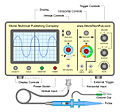VARIABLE HOLD-OFF PERIOD
Suppose a series of double pulses must be displayed. The end of the first time-base ramp is reached after pulse 5 and the end of the hold-off period is reached before pulse 6. The second sweep will then be triggered at pulse 6. This means that the following pulses appear at the screen. By making the hold-off period longer, the second sweep will be triggered by pulse 7. As a result, the waveforms during the first and second sweeps will coincide, and the proper picture will be obtained. The same result could have been obtained by shortening the time base sweep by means of the Vernier control, but then the time scale would no longer be calibrated. For this reason, a variable hold-off control is sometimes built into an oscilloscope. However, relatively few oscilloscopes possess this feature, such as the Philips PM 3260 and PM 3265. The hold-off time must be related to the time-base sweep speed. If not, at high sweep speeds the hold-off time would be too long, and the successive sweeps will appear only after a relatively long time. Consequently, a fast sweep would be displayed at a low repetition rate, which would reduce the light output (brightness) to a large extent. For this reason, the range of the hold-off time is automatically set appropriately with the TIME/mv switch.

TIME-BASE MAGNIFIER
Most oscilloscopes are provided with a magnifier switch to enable the display to be magnified along the time axis by a fixed factor, usually 5 or 10. Magnification is achieved by increasing the amplification of the horizontal amplifier. The amount of magnification is limited to 5 x or 10 x because any instability in the input signal or in the horizontal channel of the oscilloscope is also magnified. Furthermore, excessive magnification makes it difficult to locate a specific part of the waveform on the screen.
The expanded time scale provides a more detailed display and better resolution along the time axis. The start of the magnified display is determined by the setting of the horizontal position control. The magnified picture can be varied over the full range of the unmagnified sweep.
The absolute accuracy in magnified time-base measurements is somewhat reduced because the accuracy of the magnification, usually 1 to 3%, is increased to the 2 to 5% time-base accuracy.
DELAYED TIME BASE
Frequently, the user is particularly interested in only a small part of the waveform on the screen. A magnified picture, starting at an adjustable time after the start of the sweep, can enable the operator to obtain a more detailed view of an event along the time axis. However, the advantage and usefulness of a time-base magnifier are rather limited. Therefore, the more sophisticated oscilloscopes possess a delayed time-base generator. These oscilloscopes have a second time-base circuit, whose sweep is started some time (delay time) after the start of the first sweep (main time base).
A transient in a 16-bit word is viewed in more detail by using the delayed timebase facility. The main time base is (externally) triggered at t0. After some time (delay time), at about the 9th pulse, the second (delayed) time base is started. The sweep speed (T1ME/01v) of the delayed time base (OT B) is set to a higher value, resulting in magnification with respect to the main timebase (MTB).
Thus, for this operation two things must be done:
- Shift the starting point of the second sweep with respect to the main sweep.
- Set the speed of the second time-base generator to a convenient value concerning the phenomenon to be observed.
The delayed-time-base circuit consists of the same circuit elements as the main-time-base circuit and is operating as the main time base in its single sweep position. In this mode, the main time-base circuit was set manually, and the sweep was triggered only once by the first trigger pulse.
References
https://www.tiepie.com/en/fut/trigger-hold-off
http://physicsnet.co.uk/a-level-physics-as-a2/current-electricity/oscilloscopes/
https://learn.sparkfun.com/tutorials/how-to-use-an-oscilloscope







